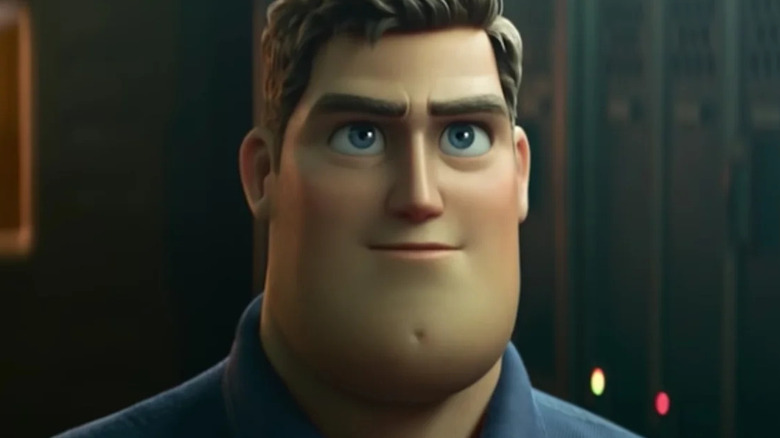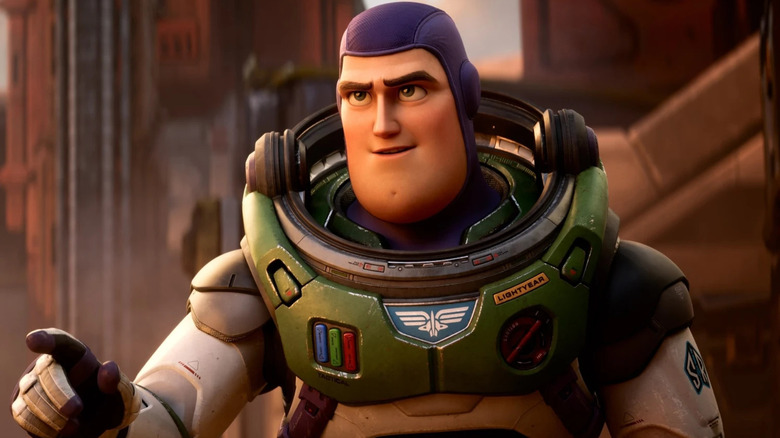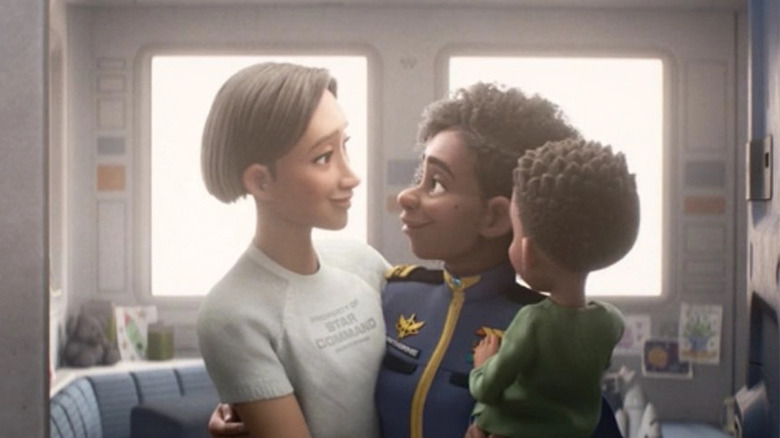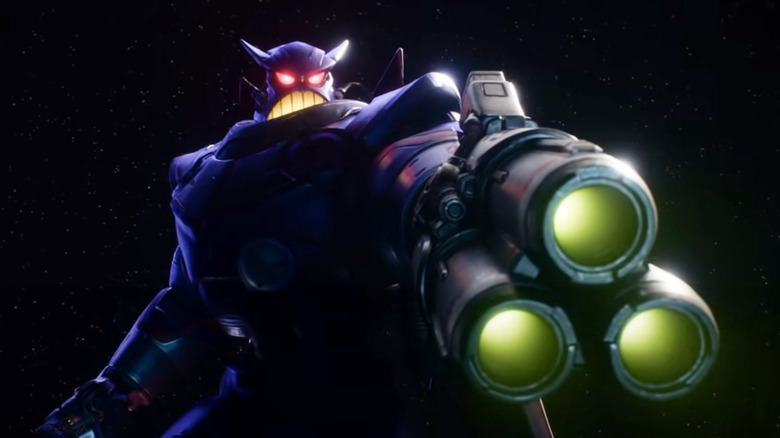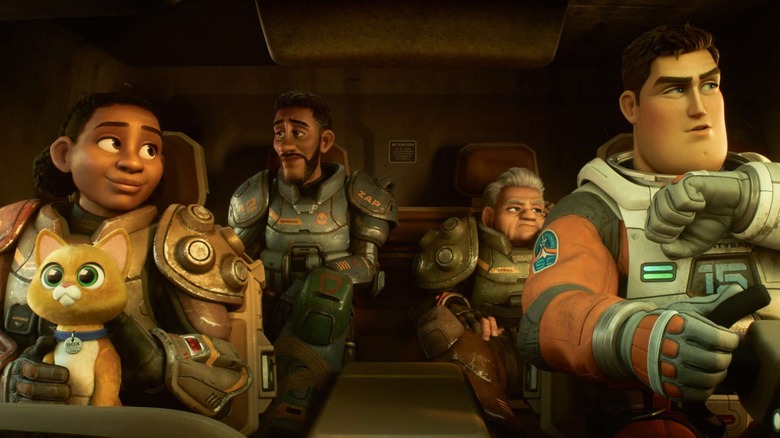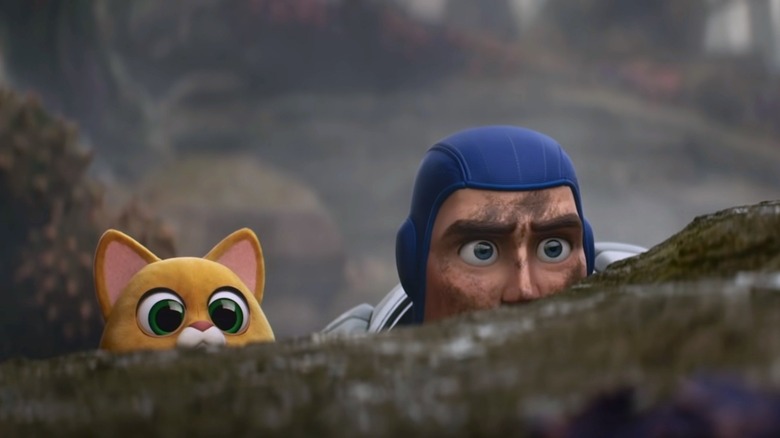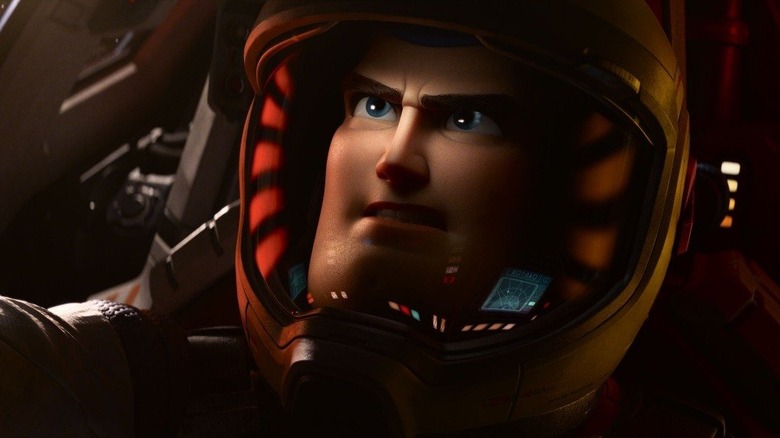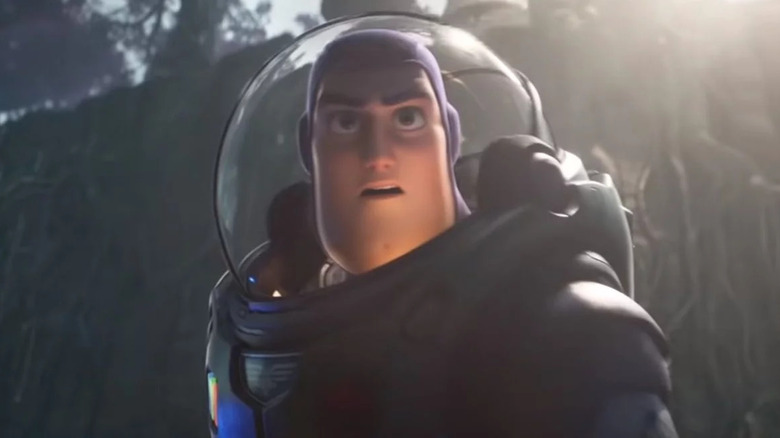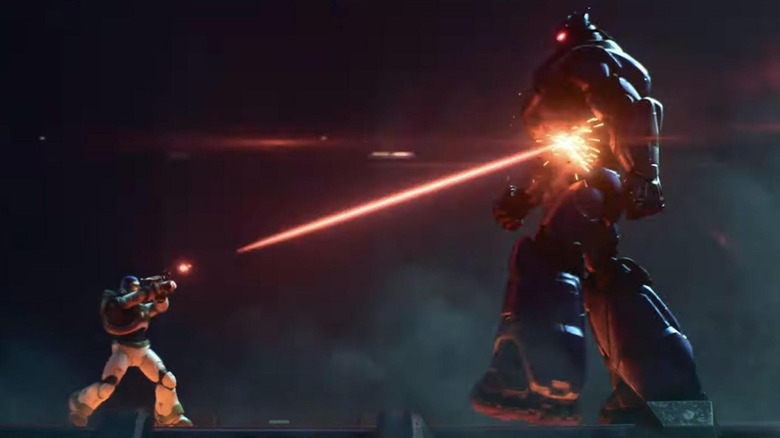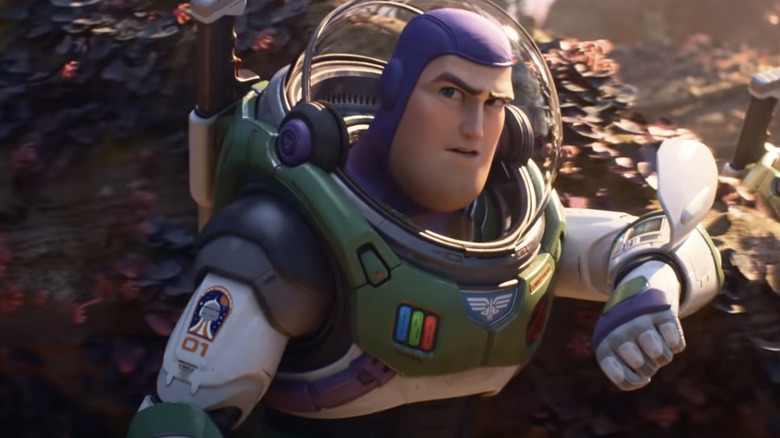Lightyear Moments That Really Upset Fans
When "Lightyear" hit the big screen in the summer of 2022, it was the first Pixar movie to release in theaters since 2020's "Onward." Between the studio's longer-than-usual theatrical absence and the movie's ties to a classic, it's safe to say its arrival was something of an event. Starring Chris Evans as the voice of the titular space ranger, "Lightyear" is meant to be a movie that exists within the "Toy Story" universe, said to be the inspiration for Andy's love for his Buzz Lightyear toy. As a Space Ranger of Star Command, Buzz discovers a habitable planet but becomes stranded there. And while he strives to reach hyperspace, he finds himself lost in time.
Upon release, "Lightyear" was a disappointment at the box office (per Den of Geek) and failed to spark the imaginations of critics and fans (via Metacritic). There were some headline-making controversies surrounding the movie during its release, and "Toy Story" fans on the internet found loads of little details to pick apart. Pixar certainly isn't above criticism, and these moments in "Lightyear" — in some cases rightfully — got a lot of flak from the fanbase.
The confusing title card
From the get-go, "Lightyear" muddles its attempt to be a coherent and meaningful prequel, and the unnecessary meta layer that the opening title card adds only ended up confusing the audience. At the very start of the movie, text appears on screen, reading, "In 1995, a boy named Andy got a toy from his favorite movie. This is that movie." This is all the context we get for this wild choice.
An immediate question that comes to mind: Was this an animated movie in 1995, or are the high fidelity visuals meant to imitate live action? Apparently the latter is true, and in the "Toy Story" universe, "Lightyear" is a live-action movie. But what exactly here would make this Andy's favorite movie?
Fans found it hard to believe Andy would have been impressed enough by this movie to become his obsession. They also found the tone didn't cohere with everything previously established in the "Toy Story" franchise. On one Reddit thread discussing the film, user rabbitarmour was in disbelief that this could have even been the movie Andy watched. "'Toy Story' already had a bit of an established Buzz Lightyear franchise and had a different tone of voice to this movie," the Reddit user wrote. "Rex is shown playing the video game of that franchise in 'Toy Story 2.'"
The same sex kiss upset conservative Disney fans
Perhaps the biggest and most absurd controversy surrounding "Lightyear" was brought up by conservative fans and pundits upon its release. Certain viewers took issue with the depiction of openly gay characters, specifically taking issue with the on-screen kiss between Alisha Hawthorne (Uzo Aduba) and her wife Kiko. Conservative thought leaders like Ben Shapiro and Ted Cruz were sending panicked tweets about Disney's "not-at-all-secret gay agenda" and how it represents the "moral collapse" of society (per Forbes).
These homophobic remarks made headlines, but the overall fallout from this brief scene had more impact than that. Initially, this led to "Lightyear" being banned in Saudi Arabia and modified in over a dozen other countries. The scene was nearly cut from the movie entirely, proving Disney's so-called LGBTQ agenda isn't really that important to the company after all. When these criticisms were first being made, star Chris Evans spoke out against the critics of the movie's same-sex kiss. "There's always going to be people who are afraid and unaware and trying to hold on to what was before, but those people die off like dinosaurs," Evans said. "I think the goal is to pay them no mind, march forward and embrace the growth that makes us human."
Zurg's design is not the same as the toy
In "Lightyear," the evil emperor Zurg's visual design has changed subtly from his "Toy Story 2" debut. Normally this wouldn't be a big issue, but Pixar has once again gotten itself in hot water for no reason at all by having "Lightyear" be the movie that inspired the toys. If Andy's Buzz toy is the exact design from the movie we just watched, then why is Zurg's costume so different?
In the "Toy Story" movies — and the questionably canon "Buzz Lightyear of Star Command" series and direct-to-video movie — Zurg was defined by a couple of standout features, namely his cape and the emblem of a letter Z on his chest plate. Both of these identifying traits are absent in "Lightyear" and the accompanying merchandise Disney is selling. This has led to speculation (via Reddit) that the Zurg in the latest Pixar movie is not the true Emperor Zurg, and may simply be an empty mech suit. The third and final post-credits scene of "Lightyear" at least suggests that this might not be the last we hear of the big purple baddie.
The infiltration sequence introduces us to a lackluster crew
One of the worst moments of "Lightyear" had fans in agreement on one thing — the underbaked supporting characters. In the second act of the movie Buzz meets Hawthorne's daughter Izzy (Keke Palmer) and her rag-tag squad of rookie soldiers, including coward Mo Morrison (Taika Waititi) and senior citizen Darby Steel (Dale Soules). They're introduced during an extended sequence in which the crew has to follow Buzz's lead and infiltrate Zurg's ship undetected.
In this sequence, "Lightyear" tries and fails to be an ensemble picture. The characters are shallow and their jokes don't land, putting them all somewhere on a scale between bland and insufferable. Fans across the large open spoilers Reddit post discussing the movie seem to be in general agreement that the characters are either annoying or forgettable. User Matthewporter18 wasn't into the movie, ultimately finding it disappointing and writing, "The whole movie was centered around his annoying misfit friends."
How did Andy watch this movie and not get a Sox toy?
This is another issue that "Lightyear" runs into because of its convoluted premise. Sox (voiced by Peter Sohn) is the adorable robotic cat that Buzz is first given when he returns from his first attempt to reach hyperspace. Over the years, since Sox doesn't age, he sticks with Buzz and becomes the funniest (and most cuddly) of the supporting characters in "Lightyear."
Sox is, admittedly, utterly adorable and one of the highlights of the movie — so much so that it raises questions. Fans on Reddit noted that if this was indeed a real movie that Andy saw when he was a kid, Sox would have been just as popular a toy as Buzz Lightyear. But of course, the cyber-kitten is nowhere to be found in "Toy Story." Reddit commenters remain skeptical that Andy wouldn't also have gotten a Sox toy to go along with his Buzz and Zurg at some point over the years. Maybe he would have thought kittens were for little girls — misguided or not, that's frankly the only explanation that makes sense.
The science behind the time dilation is a point of contention
While it's allegedly meant to be a movie from 1995, "Lightyear" definitely takes influence from more recent sci-fi movies. One of the biggest influences you can feel while watching the movie is Christopher Nolan's "Interstellar." In the first act of the movie, Buzz Lightyear is attempting to reach hyperspace speeds in order to get his crew off the planet where they've been stranded. But after his first attempt, he returns to the surface to realize that multiple years have passed. Like "Interstellar," "Lightyear" has a plot that hinges on time dilation in space travel. Each time Buzz attempts to leave the atmosphere, only a few minutes pass for him but years pass on the planet. This scientifically-proven phenomenon is real physics, but according to fans it doesn't quite work the way it does in "Lightyear."
According to Reddit user Aldarionn, the math the movie uses doesn't add up, and at the speeds Buzz was traveling the effects would not have been as extreme. "The extreme effects of Time Dilation don't happen until MUCH closer to light speed," Aldarionn wrote, "or over a very long duration at 0.8c, and the movie's science team knows this." They went on to cite other movie depictions of the phenomenon that are more accurate, including in the Marvel Cinematic Universe. Later in the post, they also pointed out that any scientist working with Buzz should have known about these effects beforehand and warned him — it would hardly have come as a twist.
The final twist is weird and divisive
In "Toy Story 2," years before Disney bought "Star Wars," Pixar made a direct reference to "The Empire Strikes Back" with evil emperor Zurg revealing to Buzz Lightyear that he didn't kill his father. "No, Buzz. I am your father," Zurg proclaims, echoing Darth Vader's iconic line. "Lightyear" takes this joke twist into consideration and takes it one step further. Fans, however, were split on how well it worked (per Reddit).
In the third act twist, Zurg is revealed to be a future version of Buzz that has traveled back in time with the intention of traveling even further back to prevent the crash landing that kicked off the whole movie. Some fans were into this. "Really difficult philosophical questions brought up in the climax," wrote user Piiman97. "To our Buzz, the existence he lives in is very real, but to Zurg it's fake." Others, like yrqrm0, found it so unsatisfying they've invented their own theories. "There is definitely a 'real' Zurg out there," they wrote. "In 'Toy Story,' Zurg is said to be from the Gamma Quadrant of Sector 4, which is where they head off to at the end of this movie."
In an interview with IGN, director Angus McClane was asked about this character decision, and gave a relevant thematic explanation. "What we were really going for was the idea that Buzz's greatest enemy is himself, literally and figuratively," McClane said, "and that it's his passion to go back in time and correct the mistake."
The time paradox doesn't get explained well enough
Speaking of the Zurg and Buzz twist, it opens up a whole unnecessary can of worms. This is the kind of multi-verse speculation fans love to dig into, so the fact that so little information was given explaining it feels like a huge missed opportunity. As Zurg/Old Buzz explains it, his timeline was created after the successful leap to hyperspeed. In the fallout from this, he was nearly arrested and was forced to escape, which sent him far into the future due to the time dilation. This is where he found the technology that allows him to travel back in time. Buzz fights back, believing that Zurg could create a paradox undoing the life of everyone he knows.
This bit is confusing, and not particularly well explained. There's no mention of how or why the timeline splinters, and the motivations of each of the characters suddenly becomes fuzzy. There have been discussions on Reddit that admit the paradox here isn't perfect, leading to speculation as to why the characters act the way they do — which is a very fundamental thing a movie should communicate to its audience. The explanations for why Old Buzz comes back and what he hopes to accomplish remain convoluted enough to confuse even diligent viewers.
When is Lightyear supposed to take place?
When all the elements of the movie's setting come together, we're still left with a confusing vision of where exactly "Lightyear" fits within the "Toy Story" timeline. As a movie that Andy watched in 1995, "Lightyear" is a part of a larger universe, but as noted earlier with the "Interstellar" influence, it has far too many modern touches to believably be a '90s film. Sci-fi movies in the '90s were often campy or satirical, like "Starship Troopers" or even 1995's own "Johnny Mnemonic." There are some references to old technology, but stylistically "Lightyear" doesn't take anything from this era.
To add a layer of confusion to the conversation, even director Angus McClane has offered uncertainty. "It might be late eighties?" MacLane said in an interview Inverse. "I always thought he watched it on VHS, so really it could come out anywhere between 1980 and 1990." This definitely puts a dent in the theory that Andy saw this in a theater in 1995, and places "Lightyear" more in line with '80s adventures like "E.T." or "The Last Starfighter," but raises many more questions about the popularity of the Buzz Lightyear character in the "Toy Story" universe.
